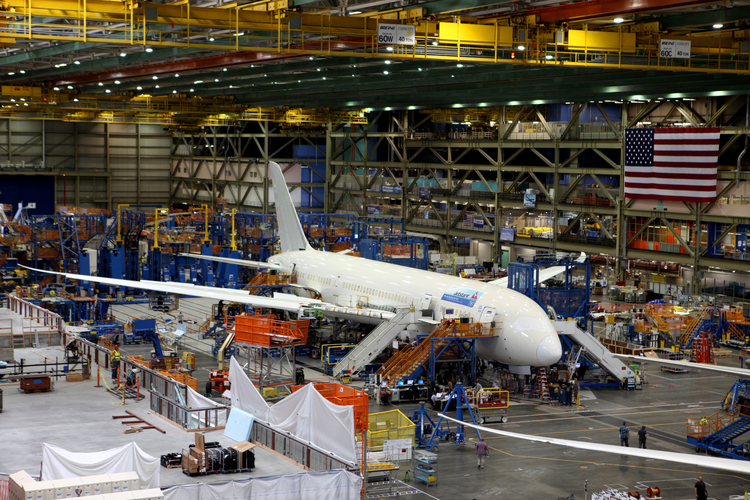Welcome to Thomas Insights — every day, we publish the latest news and analysis to keep our readers up to date on what’s happening in industry. Sign up here to get the day’s top stories delivered straight to your inbox.

As one of the world’s largest aircraft manufacturers, the world’s second-biggest defense contractor, and the U.S.’ leading exporter, The Boeing Company operates a vast, complex supply chain.
Managing an aerospace supply chain requires extremely comprehensive planning – often years in advance – to accurately project market demand changes, as well as a willingness to evolve and adapt. Everything from design tweaks to geopolitical issues can disrupt one or more elements in the lengthy chain.
Boeing manages one of the largest chains in the sector. Best known for manufacturing commercial and military airplanes, Boeing also produces “satellites, weapons, electronic and defense systems, launch systems, advanced information and communication systems, and performance-based logistics and training,” supporting major airlines, governments, and other customers in more than 150 countries.
A single Boeing airplane is made of more than three million parts, which means the company’s supply chain is a massive, global operation. More than 150,000 people are employed in more than 65 countries, not to mention the hundreds of thousands more working for Boeing suppliers across the globe.
Connecting Supply Chain Partners
The 787 Dreamliner, which first took commercial flight in 2009, marked the beginning of a new structure for Boeing’s production operations. This structural shift may serve as a useful example of operational shifts on which other companies can model their operations.
Before 2007, Boeing would send fully detailed designs to each of its partners producing different aircraft components. These partners would then send individual parts to Boeing for testing, validation, and final assembly.
With the 787, however, Boeing worked with individual suppliers that helped design, test, and validate the pieces they manufactured themselves. This meant that Boeing partners at every point in the supply chain needed to communicate with each other and with Boeing, to coordinate the timing of purchase orders, component schedules, and final delivery.
“[Supply chain] partners have unprecedented responsibility for actual delivery of major portions of the aircraft,” explained Tim Opitz, director of production and support for 787 systems integration.
This new supply chain structure helped reduce costs and increase productivity — allowing the new aircraft to be delivered quicker than ever before.
Adapting to Globalization and Shifting Demand
Boeing’s wide-reaching supply chain enables the company to adapt to changing market demands in different ways in different parts of the world.
As of 2017, Boeing derived “about 70% of aircraft revenue from international customers in more than 150 countries.” But countries where Boeing has its biggest operations, such as Japan and China, started to build their own domestic products to compete.
In response, Boeing began selling more of its products in these countries, which made working with Boeing a more attractive economic option for airlines there.
The company also initiated onshoring, bringing more of its supply chain operations back to American soil. For example, the wings of the Boeing 777, previously produced in Japan, were built entirely in the United States.
Reusing Parts, Reducing Costs
To save on costs and keep up with the demand for parts, Boeing fully manages teardowns – the process of harvesting retired planes for Used Serviceable Materials (USM).
A typical teardown reaps about 2,500 parts, but in some cases, up to 6,000 parts from a single airplane can be salvaged for reuse. Boeing previously outsourced this process to third parties, but now handles it from start to finish.
Similarly, before 2020, Boeing’s acquired brand Aviall marketed and distributed about two million different products from the Boeing catalog. In January 2020, Boeing retired the Aviall brand name to sell these products under its umbrella.
“Streamlining our operations under a single brand will further strengthen the services and support our customers know and trust from Boeing, Aviall, and legacy KLX Aerospace,” said William Ampofo, vice president of global services supply chain.
Boeing’s Response to the COVID-19 Crisis
The coronavirus pandemic has taken a toll on just about every industry’s supply chain, but it may have hit the airline industry the hardest, with air travel drastically reduced as countries closed their borders and implemented strict lockdown measures.
In response, Boeing leveraged its supply chain to spring into a different kind of action. When speaking with an N95 mask manufacturer about a worrying shortage of aluminum strips that mold masks to the wearer’s nose, Cory Cress, an employee in Boeing’s supply chain operations, realized that the company’s suppliers could step in.
“I knew that Boeing teams use similar masks in many manufacturing operations,” the employee said. “After discussing the manufacturer’s raw material specifications with other employees, we were confident that a Boeing supplier could help mitigate their raw material bottleneck.”
Boeing has found other ways to aid the response to COVID-19. In April, Boeing shipped more than 2,300 3D-printed face shields to the Department of Health and Human Services. In May, Boeing airlifted more than 150,000 units of personal protective equipment from China to the United States.
As various countries reopen their economies and U.S. suppliers return to work, Boeing has begun to resume aircraft operations.
Image Credit: Jetstar Airways / Wikimedia Commons


